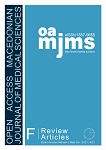The Treatment of Angiotensin-converting Enzyme Inhibitors in Coronavirus Disease 2019 Patients with Hypertension: A Narrative Review
DOI:
https://doi.org/10.3889/oamjms.2021.7159Keywords:
Coronavirus disease 2019, Hypertension, Angiotensin-converting enzyme 2, Angiotensin-converting enzyme inhibitors, Angiotensin receptor blockersAbstract
A new strain of the severe acute respiratory syndrome coronavirus 2 (SARS-CoV-2) induces coronavirus disease 2019 (COVID-19), a contagious respiratory disorder resulting in illness. Meanwhile, the World Health Organization classified this virus as a pandemic due to its rapid transmission and daily growing fatality rates. The condition is commonly manifested as clinical symptoms such as fever, cough, shortness of breath, and cardiovascular disease. Although there is a high probability of COVID-19 patients developing cardiovascular problems, such as hypertension, there is no established causative association between both conditions. In general, this type of comorbidity is extremely common in the elderly, which increases their risk of infection with the SARS-CoV-2 virus. The International Society of Hypertension issued the most recent guidelines for the treatment and management of hypertension in 2020, of which the most employed are angiotensin-converting enzyme inhibitors (ACE-i) and angiotensin receptor blockers (ARB). Therefore, this research aims to investigate the treatment of ACE-i/ARB in hypertensive individuals with COVID-19. The reason is that there have been some concerns expressed about the usage of these medications due to their influence on angiotensin-converting enzyme 2 (ACE2), which is the entrance site for SARS-CoV-2, particularly in the lungs. Subsequently, the results showed that discontinuing ACE-i/ARB is not advised, especially during the pandemic. This is based on data comparing mortality rates between participants on ACE-i/ARB and those not on ACE-i/ARB using cases and guidelines for managing hypertension during the pandemic.
Downloads
Metrics
Plum Analytics Artifact Widget Block
References
World Health Organization. Subject in Focus: Origin of the Severe Acute Respiratory Syndrome Coronavirus-2 (SARSCoV-2), the Virus Causing COVID-19. Geneva: World Health Organization; 2021. Available from: https://www.who.int/docs/default-source/coronaviruse/situation-reports/20200423-sitrep-94-covid-19.pdf [Last accessed on 2021 Jul 26].
World Health Organization. Novel Corona Disease NEWS. Situation Report 12. Geneva: World Health Organization; 2021. Available from: https://www.cdn.who.int/media/docs/defaultsource/searo/indonesia/covid19/external-situation-report-64_21-july-2021.pdf?sfvrsn=e9aec4fa_5 [Last accessed on 2021 Jul 26].
South AM, Diz DI, Chappell MC. COVID-19, ACE2, and the cardiovascular consequences. Am J Physiol Heart Circ Physiol. 2020;318(5):H1084-90. https://doi.org/10.1152/ajpheart.00217.2020 PMid:32228252 DOI: https://doi.org/10.1152/ajpheart.00217.2020
Gao C, Cai Y, Zhang K, Zhou L, Zhang Y, Zhang X, et al. Association of hypertension and antihypertensive treatment with COVID-19 mortality: A retrospective observational study. Eur Heart J. 2020;41(22):2058-66. https://doi.org/10.1093/eurheartj/ehaa433 PMid:32498076 DOI: https://doi.org/10.1093/eurheartj/ehaa433
Unger T, Borghi C, Charchar F, Khan NA, Poulter NR, Prabhakaran D, et al. International society of hypertension global hypertension practice guidelines. Hypertension. 2020;75(6)1334- 57. https://doi.org/10.1161/HYPERTENSIONAHA.120.15026 PMid:32370572 DOI: https://doi.org/10.1161/HYPERTENSIONAHA.120.15026
European Society of Cardiology. Hypertension and COVID-19; 2020. Available from: https://www.escardio.org/education/covid-19-and-cardiology/esc-covid-19-guidance [Last accessed on 2020 Jun 16].
Yang G, Tan Z, Zhou L, Yang M, Peng L, Liu J, et al. Angiotensin II Receptor Blockers and Angiotensin-Converting Enzyme Inhibitors Usage is Associated with Improved Inflammatory Status and Clinical Outcomes in COVID-19 Patients with Hypertension, MedRxiv; 2020. DOI: https://doi.org/10.1101/2020.03.31.20038935
Mancia G, Rea F, Ludergnani M, Apolone G, Corrao G. Reninangiotensin-aldosterone system blockers and the risk of COVID- 19. N Engl J Med. 2020;382(25):2431-40. DOI: https://doi.org/10.1056/NEJMoa2006923
Muneer K, Nair A. Angiotensin-converting enzyme inhibitors and receptor blockers in heart failure and chronic kidney diseasedemystifying controversies. Indian Heart J. 2017;69(3):371-4. https://doi.org/10.1016/j.ihj.2016.08.007 PMid:28648436 DOI: https://doi.org/10.1016/j.ihj.2016.08.007
Rudiansyah M, Nur’amin HW, Nugrahaningsih DA, Bandiara R, Roesli RM. COVID-19: Drug development and kidney related problems. Syst Rev Pharm. 2020;11(7):106-12.
Rudiansyah M, Nur’amin HW, Lubis L, Bandiera R, Roesli RM, Rachmadi D. COVID-19 and kidney diseases in Indonesia. Syst Rev Pharm. 2020;11(7):435-42.
Jang F, Yang J, Zhang Y, Dong M, Wang S, Zhang Q, et al. Angiotensin-converting enzyme 2 and angiotensin 1-7: Novel therapeutic targets. Nat Rev Cardiol. 2014;11(7):413-26. https://doi.org/10.1038/nrcardio.2014.59 PMid:24776703 DOI: https://doi.org/10.1038/nrcardio.2014.59
Lu J, Sun PD. High affinity binding of SARS-CoV-2 spike protein enhances ACE2 carboxypeptidase activity. bioRxiv. 2020;2020:182659. https://doi.org/10.1101/2020.07.01.182659 PMid:32637947 DOI: https://doi.org/10.1101/2020.07.01.182659
Heurich A, Hofmann-Winkler H, Gierer S, Liepold T, Jahn O, Pöhlmann S. TMPRSS2 and ADAM17 cleave ACE2 differentially and only proteolysis by TMPRSS2 augments entry driven by the severe acute respiratory syndrome coronavirus spike protein. J Virol. 2014;88(2):1293-307. https://doi.org/10.1128/JVI.02202-13 PMid:24227843 DOI: https://doi.org/10.1128/JVI.02202-13
Simões e Silva AC, Silveira KD, Ferreira AJ, Teixeira MM. ACE2, angiotensin-(1-7) and Mas receptor axis in inflammation and fibrosis. Br J Pharmacol. 2013;169(3):477-92. https://doi.org/10.1111/bph.12159 PMid:23488800 DOI: https://doi.org/10.1111/bph.12159
Kuba K, Imai Y, Rao S, Jiang C, Penninger JM. Lessons from SARS: Control of acute lung failure by the SARS receptor ACE2. J Mol Med (Berl). 2006;84(10):814-20. https://doi.org/10.1007/s00109-006-0094-9 PMid:16988814 DOI: https://doi.org/10.1007/s00109-006-0094-9
Jia, H. Pulmonary angiotensin-converting enzyme 2 (ACE2) and inflammatory lung disease. Shock. 2016;46(3):239-48. https://doi.org/10.1097/SHK.0000000000000633 PMid:27082314 DOI: https://doi.org/10.1097/SHK.0000000000000633
Tignanelli CJ, Ingraham NE, Sparks MA, Reilkoff R, Bezdicek T, Benson B, et al. Antihypertensive drugs and risk of COVID-19? Lancet Respir Med. 2020;8(5):e30-1. https://doi.org/10.1016/S2213-2600(20)30153-3 PMid:32222166 DOI: https://doi.org/10.1016/S2213-2600(20)30153-3
Goyal A, Cusick AS, Thielemier B. ACE inhibitors. In: StatPearls. Treasure Island, FL: StatPearls Publishing; 2020.
Inciardi RM, Lupi L, Zaccone G, Italia L, Raffo M, Tomasoni D, et al. Cardiac involvement in a patient with Coronavirus disease 2019 (COVID-19). JAMA Cardiol. 2020;5(7):819-24. https://doi.org/10.1001/jamacardio.2020.1096 PMid:32219357 DOI: https://doi.org/10.1001/jamacardio.2020.1096
Cancarevic I, Malik BH. SARS-CoV-2 (COVID 19) infection in hypertensive patients and in patients with cardiac disease. Cureus. 2020;12(6):e8557. https://doi.org/10.7759/cureus.8557 PMid:32670694 DOI: https://doi.org/10.7759/cureus.8557
Imai Y, Kuba K, Rao S. Angiotensin-converting enzyme 2 protects from severe acute lung failure. Nature. 2005;436(7047):112-6. https://doi.org/10.1038/nature03712 PMid:16001071 DOI: https://doi.org/10.1038/nature03712
Zhang P, Zhu L, Cai J, Lei F, Qin JJ, Xie J, et al. Association of inpatient use of angiotensin-converting enzyme inhibitors and angiotensin II receptor blockers with mortality among patients with hypertension hospitalized with COVID-19. Circ Res. 2020;126(12):1671-81. https://doi.org/10.1161/CIRCRESAHA.120.317134 PMid:32302265 DOI: https://doi.org/10.1161/CIRCRESAHA.120.317134
Li J, Wang X, Chen J, Zhang H, Deng A. Association of reninangiotensin system inhibitors with severity or risk of death in patients with hypertension hospitalized for Coronavirus disease 2019 (COVID-19) infection in Wuhan, China. JAMA Cardiol. 2020;5(7):825-30. https://doi.org/10.1001/jamacardio.2020.1624 PMid:32324209 DOI: https://doi.org/10.1001/jamacardio.2020.1624
Downloads
Published
How to Cite
Issue
Section
Categories
License
Copyright (c) 2021 Mohammad Rudiansyah, Haryati Haryati, Enita Rakhmawati Kurniaatmaja, Nanik Tri Wulandari, Lily Runtuwene, Aqsha Tiara Viazelda, Mohammad Agung Raihan Rudiansyah (Author)

This work is licensed under a Creative Commons Attribution-NonCommercial 4.0 International License.
http://creativecommons.org/licenses/by-nc/4.0








